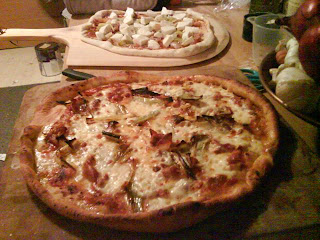Well, I went ahead and tossed those rules out and made a pair of pizzas with a red sauce made from sweet heirloom tomatoes. To top the pies, I went with leeks, and paired with that was pancetta, which is a higher quality of cured pork belly very similar to bacon:

The sauce was very easy. Basically, I crushed and minced four cloves of garlic, added two tablespoons of olive oil to a two quart pot, and let the garlic fry for a little on medium heat. I roughly cut up the heirloom tomatoes and added them to the pot with a cup of dry white wine, and brought that up to a boil for a bit to reduce the alcohol out. Once that was done, I put a teaspoon of dried basil, a teaspoon of dried oregano, a teaspoon of salt, and a teaspoon of sugar in the mix, and topped it off with a bay leaf, and left it to simmer on a very low heat for 45 minutes.

While that was simmering, I worked together a crust. It was similar to the one I made before, but with semolina flour instead of whole wheat in a 1:2 ratio to all purpose. Instead of rosemary, I worked in oregano to give it a rustic taste.
While that was resting, I preheated my pizza stone to 500 degrees. I took out a skillet and fried up the pancetta pieces (You can get pancetta either rolled or in strips. The stuff I used was rolled) about halfway done, so that it would be able to fully cook in the oven. I set the pancetta aside, reserved the fat in the pan, and then washed and chopped my leek into strips about two inches long. With the reserved pancetta fat, I cooked down the leeks until they were very tender and separated, and set those aside as well.
When the dough was ready, I punched that down, divided it in half, and worked each piece at a time to make a wide crust. I eased that onto my peel, which had corn meal sprinkled on it. Then I spooned the sauce on the crust, spreading it evenly, then added one and a half cubed balls of mozzarella di bufala, along with my leek pieces and torn bits of pancetta. Then, it was oven time! Ten minutes of a roaring oven (approximately) and it was done.

The sweet in the sauce and the leek paired with the salty pancetta really nicely. This wasn't red sauce and meat for the sake of each. They paired well. That should be the reason you put anything together. Not because "thats how its always done" but because it tastes right. If I were making pizza margherita, I'd use a red sauce with that too, because the entire point is to celebrate the interaction of tomato and basil. So yes, rules can be broken, but be a dear and have a reason for breaking them.

